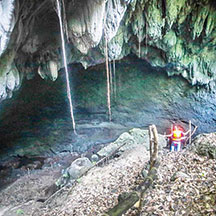QUEZON CITY – The country now has a total of 415 classified caves, which the government is required to preserve and ensure their sustainable use.
This developed as the Department of Environment and Natural Resources (DENR) has classified an additional 51 caves to guide communities on their responsible management. Prior to this, 364 caves had already been classified by the agency according to their characteristics.
“As with other natural resources, caves are natural treasures that we need to protect for the enjoyment of future generations, because they are important wildlife habitats and possess significant geological, cultural, historical and archaeological values,” DENR Secretary Ramon J.P. Paje said in DENR Memorandum Circular No. 2015-08.

“This circular will guide the DENR, particularly the Biodiversity Management Bureau (BMB), and other concerned agencies and offices, including local government units on how to use our caves and cave resources appropriately,” he added.
The memo circular was pursuant to Republic Act No. 9072, also known as the National Caves and Cave Resources Management and Protection Act. The law tasks the DENR to formulate, develop and implement a cave management program to conserve and protect the country’s cave resources.
Seven caves were categorized as Class I for their delicate and fragile geological formations and threatened species. These include the Nical Cave in Dasol, Pangasinan; the Sung Wan and Kaping Caves in Tayabas City, Quezon; and the Burial Cave in Caraga, Davao Oriental.
Class I caves are limited to mapping, photography, educational and scientific purposes, and are closed for ecotourism activities.
The memo circular categorized 36 Class II caves. These have sections with hazardous conditions and high quality ecosystems that are highly sensitive to human activities, making it necessary to close these sections either seasonally or permanently except for experienced cavers and guided tours or visits.
Class II caves include the Capilan Bat Cave in Sultan KudarTa, Licup Cave in Samal Island, Davao, and Guano Cave in Bangui, Ilocos Norte.
Class III caves have no known threatened species within them or significant archaeological, geological, natural history, cultural and historical values. Such caves are open to inexperienced yet guided visitors. They may also open to guano extractors and birds’ nest collectors, if any.
Eight caves were categorized as Class III, which include Balite Cave in Samal Island, and six Punta Diwata Caves in Carmen City, Agusan del Norte.
The distribution of the newly classified caves are as follows: six in the Ilocos region (Region I); nine in CALABARZON Region (Region 4A); 19 in the Davao region (Region 11); three in South Central Mindanao (Region 12); 14 in the Caraga Region (Region 13).
With the classification, BMB personnel in the respective DENR field offices will coordinate with the Protected Area Management Board, concerned local government unit or land owner in the preparation and implementation of a management plan on related activities within the caves.
TRAVEL
PHL now has 415 classified caves
Archives
- April 2019 (3)
- January 2016 (13)
- December 2015 (13)
- October 2015 (14)
- September 2015 (16)
- August 2015 (15)
- July 2015 (15)
- June 2015 (1)
- May 2015 (15)
- April 2015 (15)
- March 2015 (28)
- February 2015 (1)
- January 2015 (31)
- December 2014 (16)
- November 2014 (16)
- October 2014 (31)
- September 2014 (31)
- August 2014 (36)
- July 2014 (32)
- June 2014 (29)
- May 2014 (28)
- April 2014 (15)
- March 2014 (51)
- February 2014 (30)
- January 2014 (33)
- December 2013 (31)
- November 2013 (31)
- October 2013 (32)
- September 2013 (31)
- August 2013 (30)
- July 2013 (18)
- June 2013 (33)
- May 2013 (33)
- April 2013 (38)
- March 2013 (36)
- February 2013 (35)
- January 2013 (35)
- December 2012 (47)
- November 2012 (36)
- October 2012 (48)
- September 2012 (28)
- August 2012 (38)
- July 2012 (30)
- June 2012 (30)
- May 2012 (31)
- April 2012 (29)
- March 2012 (30)
- February 2012 (30)
- January 2012 (37)
- December 2011 (48)
- November 2011 (23)
- October 2011 (69)
- September 2011 (46)
- August 2011 (30)
- July 2011 (79)
- June 2011 (30)
- May 2011 (66)
- April 2011 (66)
- March 2011 (39)
- February 2011 (67)
- January 2011 (146)
- December 2010 (124)
- November 2010 (122)
- October 2010 (163)
- September 2010 (98)
- August 2010 (101)
- July 2010 (146)
- June 2010 (72)



 ShareThis
ShareThis